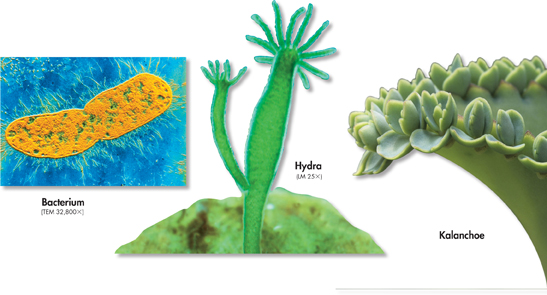Cell Division and Reproduction
 How do asexual and sexual reproduction compare?
How do asexual and sexual reproduction compare?
Reproduction, the formation of new individuals, is one of the most important characteristics of living things. For an organism composed of just one cell, cell division can serve as a perfectly good form of reproduction. You don't have to meet someone else, conduct a courtship, or deal with rivals. All you have to do is to divide, and presto—there are two of you!

FIGURE 10–3 Asexual Reproduction Cell division leads to reproduction in single-celled organisms and some multicellular organisms. Apply Concepts What do the offspring of each of these organisms have in common?
Asexual Reproduction For many single-celled organisms, such as the bacterium in Figure 10–3, cell division is the only form of reproduction. The process can be relatively simple, efficient, and effective, enabling populations to increase in number very quickly. In most cases, the two cells produced by cell division are genetically identical to the cell that produced them. This kind of reproduction is called asexual reproduction.  The production of genetically identical offspring from a single parent is known as asexual reproduction.
The production of genetically identical offspring from a single parent is known as asexual reproduction.
Asexual reproduction also occurs in many multicellular organisms. The small bud growing off the hydra will eventually break off and become an independent organism, an example of asexual reproduction in an animal. Each of the small shoots or plantlets on the tip of the kalanchoe leaf may also grow into a new plant.
Sexual Reproduction Unlike asexual reproduction, where cells separate to form a new individual, sexual reproduction involves the fusion of two separate parent cells. In sexual reproduction, offspring are produced by the fusion of special reproductive cells formed by each of two parents.  Offspring produced by sexual reproduction inherit some of their genetic information from each parent. Most animals and plants reproduce sexually, and so do some single-celled organisms. You will learn more about the form of cell division that produces reproductive cells in Chapter 11.
Offspring produced by sexual reproduction inherit some of their genetic information from each parent. Most animals and plants reproduce sexually, and so do some single-celled organisms. You will learn more about the form of cell division that produces reproductive cells in Chapter 11.
 In Your Notebook Use a Venn diagram to compare asexual and sexual reproduction.
In Your Notebook Use a Venn diagram to compare asexual and sexual reproduction.
BUILD Vocabulary
PREFIXES The prefix a- in asexual means “without.” Asexual reproduction is reproduction without the fusion of reproductive cells.
Table of Contents
- Formulas and Equations
- Applying Formulas and Equations
- Mean, Median, and Mode
- Estimation
- Using Measurements in Calculations
- Effects of Measurement Errors
- Accuracy
- Precision
- Comparing Accuracy and Precision
- Significant Figures
- Calculating With Significant Figures
- Scientific Notation
- Calculating With Scientific Notation
- Dimensional Analysis
- Applying Dimensional Analysis




